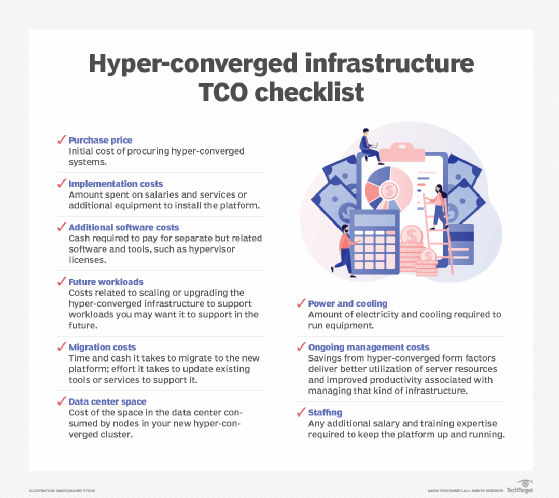Examining hyper-converged infrastructure costs and savings
There are several factors to consider when calculating HCI costs, including licensing, storage, networking and CPU types. In addition, costs might include support contracts.
On the surface, hyper-converged systems might seem budget-friendly. But watch out for pricey feature options that can increase overall hyper-converged infrastructure costs as you build.
Hyper-converged infrastructures (HCIs) have long been marketed as the technology to reduce IT infrastructure costs, while also improving business agility. Even so, the cost of a hyper-converged system can be comparable to that of a more traditional system.
Factors to consider when calculating HCI costs
In some ways, investing in a hyper-converged system is like purchasing a new car. The base model might be reasonably priced, but costs can quickly increase as you begin adding features. With that in mind, here are some of the features that have the biggest effect on the price of a hyper-converged system.
Licensing
One of the factors that can affect the overall IT infrastructure costs of a hyper-converged system is software licensing. Hyper-converged systems are typically bundled with a hypervisor and systems management software for the virtualization stack, and there are licensing costs associated with this software.
Hyper-converged products that use software from VMware or Microsoft incur higher licensing costs than those that use an open source hypervisor.
Storage
Data storage also plays a major role in the overall price of a hyper-converged system, and it can affect IT infrastructure costs in several different ways. For starters, the price of a hyper-converged system can vary based on the number of drive slots that exist in a node. Although an empty drive slot might not seem to be a big-ticket item, each drive slot requires a disk controller, and the number of drive slots can also affect the node's required form factor -- 1U, 2U, etc.

Just as the number of drive slots can influence price, so, too, can the number of drives that are actually installed. Beyond the costs associated with the drive, some vendors won't sell nodes with empty drive slots, and, therefore, use a combination of the raw drive capacity and the number of nodes to determine the overall storage capacity. For example, if a vendor installs six drives into each node, that vendor might offer an 18-drive/three-node configuration or a 24-drive/four-node configuration.
Of course, the types of drives that are installed into the nodes also play a significant role in the overall price. Manufacturers generally offer customers a choice between flash storage, spinning disks or some combination of the two. Among these various drive types, manufacturers often offer a variety of raw capacities and speeds. All these factors affect the cost of the drive, and the cost of the hyper-converged system as a whole.
Networking
Hyper-converged system vendors offer a variety of networking hardware choices. This is especially true of the network ports that exist within the individual nodes. Generally speaking, vendors give customers at least a couple of options that vary based on the number of ports, the port speed and the port connectivity type. For example, a vendor might offer customers a choice between having four 1 Gbps RJ45 ports and two 10 Gbps SFP+ ports per node.
In addition, a hyper-converged systems vendor might offer different optional port types. Some vendors, for example, give customers the option of adding an out-of-band management port, while other vendors include this as a standard option.
CPU
The CPU is another hyper-converged system component that can dramatically affect IT infrastructure costs. Most manufacturers offer customers a choice of a few different CPU types. For example, a manufacturer might offer a choice between an Intel Xeon-Gold 5118 and an Intel Xeon-Platinum 8158 that costs approximately four times as much.
Although it's true that some CPUs are more expensive than others, there are two factors that affect costs much more than the price of the CPU.
The first factor is the cumulative CPU cost. Most nodes in hyper-converged systems include multiple CPU slots, and multiple nodes are designed to work together to form the hyper-converged system. A relatively modest four-node system could conceivably contain 16 processors. Hence, any CPU price difference that exists would be multiplied by the total number of CPUs that are installed in the nodes.
When it comes to software licensing, many vendors license their software based on the number of CPUs that are installed in a server. Hence, a multi-CPU system won't only cost more in terms of hardware, but might also incur higher licensing fees.
Miscellaneous costs
Manufacturers can also alter the price of hyper-converged systems through several different miscellaneous costs. Such costs might include mandatory warranties or support contracts, memory options or even the option to add a battery backup to a storage controller.
Hyper-converged infrastructure costs can vary widely depending on the hardware and software specifications. One additional factor that can have a dramatic effect on the overall cost is the brand. Some vendors charge a premium price for their products, while others charge less.
Comparing HCI costs to traditional infrastructure
There are several ways to compare the cost of an HCI platform to that of a traditional system. The most obvious method is to base the comparison on absolute dollars, but this certainly isn't the only method.
Another popular method for establishing cost is to tie the cost to use case. One of the most common use cases for hyper-converged systems, for example, is virtual desktop infrastructure. As such, an organization might establish a cost per virtual desktop. Each node in a hyper-converged system can host a specific number of virtual desktops. Dividing the node's cost by the number of virtual desktops the node can accommodate will provide the per-virtual desktop cost. A similar comparison can be made for traditional hardware platforms.
Hyper-converged infrastructure savings
Early on, much of the cost savings associated with hyper-converged infrastructure platforms were associated with the hardware cost. Today, however, hyper-converged systems aren't always based on commodity hardware and can easily be as costly as a traditional system. Even so, it's still possible to save money by adopting a hyper-converged platform.
Some of the cost savings stem from the fact that hyper-converged platforms are self-contained, integrated systems. This means you won't incur costs such as those related to deploying and maintaining a SAN.
There might also be cost savings tied to reduced complexity and lower management costs. Hyper-converged systems are often preconfigured to provide high availability for critical applications. This means IT pros don't have to manually create clusters and provision storage to make critical applications highly available.
Weighing the options
Although hyper-converged infrastructure systems are often marketed as platforms for smaller organizations or branch offices, HCI systems can also be a good fit for the enterprise. Some HCI systems are assembled from commodity hardware, but many HCI vendors also offer premium hardware options. As such, there can be dramatic price differences between HCI platforms.







